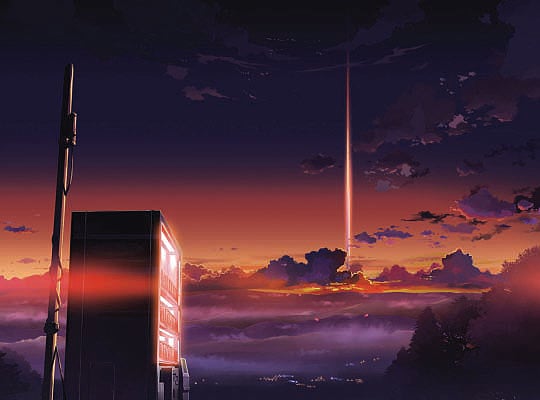HOW-TO, Techniques, & Best Practices Channel
| Makoto Shinkai: Do-It-Yourself Animator By Patrick Drazen posted Mar 26, 2008, 14:42 |
Click here to get a copy of the May 2006 Edition, so you can read and enjoy all of the excellent articles inside. Check out this article in the May 2006 print edition of StudentFilmmakers magazine, page 10 .

Author of the 2003 Anime Explosion: The What? Why? and Wow! of Japanese Animation, Patrick Drazen has presented at the 2004 Schoolgirls and Mobilesuits, at Yaoi-Con in 2002, at the 2006 Anime Marathon at the Freer Gallery of the Smithsonian Institution, and for several years at Anime Central in his hometown of Chicago. He's written on anime for Animation magazine, and is currently working on his second book.
Makoto Shinkai: Do-It-Yourself Animator
 One of the biggest revolutions in filmmaking has come with the
computer. Elaborate, even impossible, special effects can be
produced with a few keystrokes. Even animation, which used to
require a small army of inkers and in-betweeners, has felt the
impact of the electronic age. Where computer-generated
characters were once limited in their design and movement, CG
images now rival traditional cel animation in warmth and
character. The growing sophistication of both hardware and
software gives animators a tool-kit that seems to be growing bigger
every day.
One of the biggest revolutions in filmmaking has come with the
computer. Elaborate, even impossible, special effects can be
produced with a few keystrokes. Even animation, which used to
require a small army of inkers and in-betweeners, has felt the
impact of the electronic age. Where computer-generated
characters were once limited in their design and movement, CG
images now rival traditional cel animation in warmth and
character. The growing sophistication of both hardware and
software gives animators a tool-kit that seems to be growing bigger
every day.
For that matter, you don’t even need a Pixar-sized corporation to produce stellar animation. In Japan, where animation isn’t a “just for kids” medium, several young filmmakers have bypassed film altogether, creating computer animation with the look and the emotional “feel” of cel animation. And people are taking note.
Makoto Shinkai was born in 1973 in Nagano Prefecture, in the “Japanese Alps.” Anime wasn’t a large part of his childhood: “I couldn't watch many of them because I lived in the countryside, and my hometown's TV station had a small number of channels.” One that did stick with him, and many viewers, was the anime version of Anne of Green Gables, whose animators included Hayao Miyazaki and Isao Takahata, founders of Studio Ghibli.
Shinkai traveled to Tokyo to attend college where he studied literature and started drawing children’s books. He also got a job doing animation for a computer game company, and this is where his studies and his background began to come together. After five years of creating animated videogame “cuts” (action/romantic/musical sequences meant to advance the plot, and not part of the gameplay), he began trying to make his own short animations at home on a Power Mac G4 running Adobe Photoshop and Adobe AfterEffects, with only the help of a girlfriend to provide a voice. His first major success was a 5-minute short titled Kanojo to Kanojo no Neko (She and Her Cat).
Told in a black-and-white style heavily influenced by French New Wave cinema, this film is a series of ten short vignettes from the point of view of a cat adopted by a Tokyo office lady. We see him watching her move around her tiny apartment getting ready for her day, watching the weather, watching as she gets a phone call that leaves her in tears (perhaps the end of a love affair). We know that, despite the difference in species, the cat sees himself as her lover. In the end, with the cat at home and the woman riding the subway, they state the same thought at the same time: “we like our life.”
She and Her Cat is told with the limited means of a children’s picture book, but it became the Grand Prize winner in a computer animation contest sponsored by Project Team DoGA, a not-forprofit foundation to promote independent CG filmmaking. Yutaka Kamata, head of the foundation, said while presenting Shinkai with the Grand Prize, “In the Japanese CG community, a professional CG creator has to be an ‘operator,’ who in making images defers to his clients and his supervisor, and has almost no chance to have his own name known. The CG community truly needs a ‘creator.’ Not a mere operator, but one who plans for himself, makes by himself, presents under his own name, and consistently make his living that way.”
Privately, Kamata gave Shinkai some advice: “Make more showy entertainment.”
The opportunity to make more CG animation came soon. She and Her Cat was shown to Yoshihiro Hagawara, a producer at CoMix Wave. He was so impressed that he arranged for CoMix Wave to support Shinkai, an independent animator who still didn’t have a commercial production to his name. Still, this support allowed the 27-year-old Shinkai to quit his day job and devote himself to his next project.
That new project was a 25 minute, full color animation, Hoshi no Koe (literally “Voice of a Star”, known in the west as “Voices of a Distant Star”). The story falls back on science fiction, a mainstay of anime, but also continues the lyrical quality of She and Her Cat. It’s a long-distance romance between two junior high school students, Noburo and Mikako. This particular relationship, set about 40 years in the future, gets sidetracked when the girl, Mikako, becomes part of an elite group of fighters training under extraterrestrial guidance to fight an intergalactic enemy. But the battle isn’t the point of the plot; it’s the fact that Mikako can only communicate with her boyfriend on Earth by text-messaging. As she moves deeper into space, the messages take longer and longer to reach their destination; can this long-distance relationship work out?
Hoshi no Koe definitely worked out for Shinkai. The anime won several awards, including one for Shinkai as Best Director in the 2002 AMD Awards. And, just as She and Her Cat led to bigger things, Hoshi no Koe led Shinkai to direct a feature-length anime.
Again, science fiction is the genre, except that it’s an alternate past rather than a potential future. The mysterious title The Place Promised in Our Early Years refers to three students: Hiroki, his friend Tayuka, and Hiroki’s sort-of girlfriend Sayuri. Hiroki is building a mini-plane in order to leave their home in the north of Japan (also Shinkai’s home) to investigate a strange tower, rising out of sight, on the northern island of Hokkaido. Fast-forward three years: Sayuri is in a coma, and the childish ambition of building and flying a plane has taken on interplanetary significance.
Once again, Shinkai allows the story to unfold languidly, even lyrically, showing that the French New Wave influence of She and Her Cat still serves him well. The popularity of the film in Japan has also proven that Shinkai knew what he was doing on his first professional feature. The Place Promised won the 2004 Mainichi Film Award for Animation over veteran directors such as Hayao Miyazaki (Spirited Away) and Katsuhiro Otomo (Akira).
If there can be a secret to Shinkai’s success, it probably comes from two sources. One is his ability as a writer. Even in a visual medium, what Spielberg said when he received the Irving Thalberg award is still true: in the beginning is the word. A film relies on its language, and Shinkai’s films are lyrical enough to keep the audience interested.
The second source is Shinkai’s love for the CG medium. Working at a computer is a solitary pursuit, but so is creating children’s books. Shinkai can still find a kind of play in his medium: “While I was using 3D modeling software, I could build a 3D world in front of my eyes as though I'm playing some kind of game. Thus I enjoyed the task itself.”
Whatever’s next for Makoto Shinkai will probably involve resources stronger than a Power Mac G4.
This article may not be reprinted in print or internet publications without express permission of StudentFilmmakers.com.
| Don't miss another important edition of StudentFilmmakers magazine which focuses on cutting-edge, pre-production, production, post production, and distribution technologies and techniques. Six-month, 1-year, 2-year, and 3-year subscriptions available with discounts from the cover price. Back Issues are also available while copies last. Go to www.studentfilmmakers.com/store >> |
StudentFilmmakers magazine, the #1 Educational Resource for Film and Video Makers, publishes 12 editions per year. Subscribe today and get this important magazine delivered right to your doorstep every month. Each edition contains high level, educational articles for serious filmmakers and videographers like you - articles including cutting edge, real-world practices, trends, and technology, as well as in-depth inspiring interviews with independent filmmakers and experts.
There is something for everyone in each issue, whether you are a director, cinematographer, camera operator, gaffer, editor, producer, sound engineer, animator, composer, actor, screenwriter, ... With today's technology changes coming faster and faster, we are all students.
StudentFilmmakers magazine would like to hear from you!
Click here to share your comments and feedback about the magazine, monthly editions, your favorite articles, and your favorite topics.
We always welcome and appreciate your Reader Comments. View them here, and send yours to the editors today!
